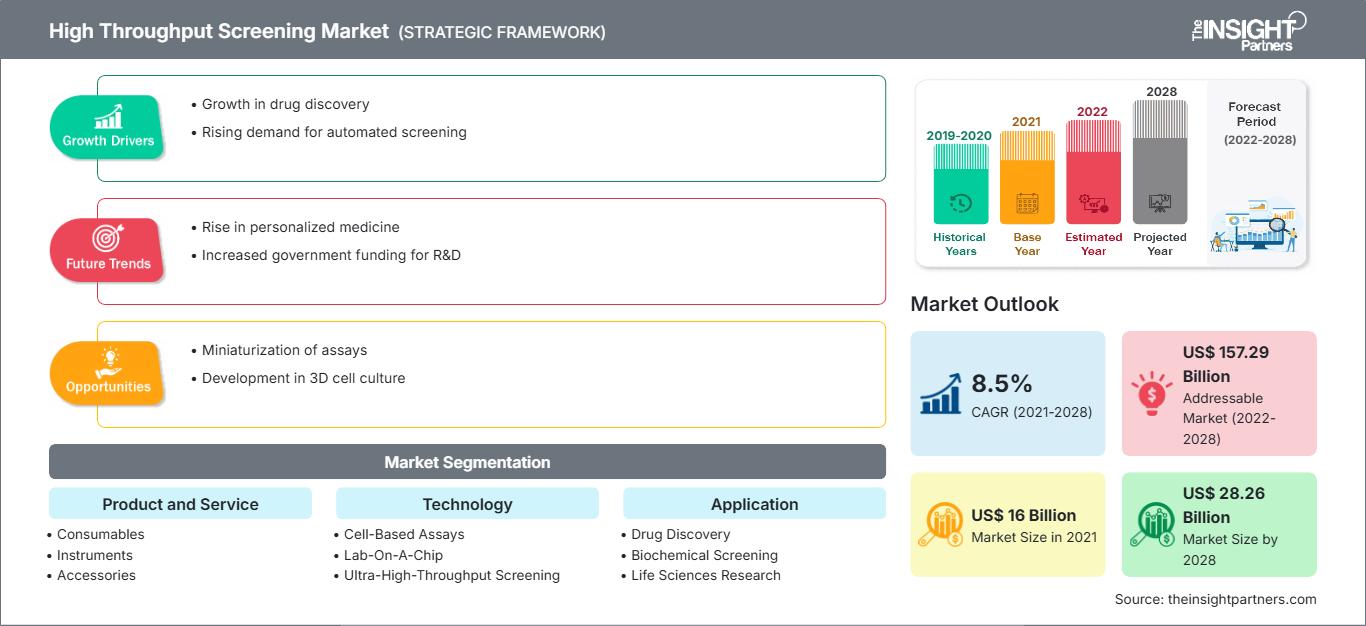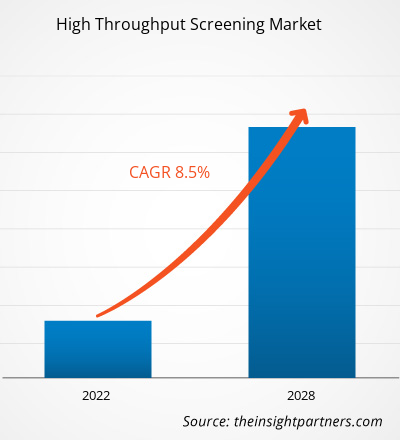Le marché du criblage à haut débit devrait atteindre 28 255,71 millions de dollars américains d'ici 2028, contre 15 997,47 millions de dollars américains en 2021. Le marché devrait croître à un TCAC de 8,5 % entre 2021 et 2028.
Le criblage à haut débit (HTS) est une méthode de découverte de médicaments qui permet de tester automatiquement divers composés chimiques ou biologiques pour une cible biologique spécifique. Les méthodes de criblage à haut débit sont largement utilisées dans l'industrie pharmaceutique, s'appuyant sur la robotique et l'automatisation pour tester rapidement l'activité biologique ou biochimique d'un nombre important de molécules, généralement des médicaments. Elles accélèrent l'analyse des cibles, car des bibliothèques de composés à grande échelle pourront bientôt être criblées de manière rentable. Le HTS est un outil précieux pour évaluer les cibles pharmacologiques, profiler pharmacologiquement les agonistes et les antagonistes des récepteurs (tels que les GPCR) et des enzymes. Des facteurs tels qu'une augmentation des investissements dans la recherche et Le développement de l'industrie pharmaceutique et biotechnologique et l'introduction de produits technologiquement avancés sur le marché du criblage à haut débit devraient stimuler la croissance du marché au fil des ans. Cependant, le coût élevé du criblage à haut débit, le manque de professionnels qualifiés et la complexité du développement des tests devraient freiner la croissance du marché dans les années à venir.
Aperçu du marché
Augmentation des investissements en recherche et développement par l'industrie pharmaceutique et biotechnologique
L'augmentation des dépenses de R&D des entreprises pharmaceutiques et biotechnologiques et l'important développement de nouveaux médicaments pour traiter diverses maladies chroniques telles que les troubles cardiovasculaires, le cancer, les troubles immunologiques, les troubles métaboliques et les troubles neurologiques sont des moteurs importants du marché du criblage à haut débit. Plusieurs entreprises pharmaceutiques, grandes et petites, sont impliquées dans le développement et la fabrication de nouvelles molécules pour plusieurs maladies potentiellement mortelles. Cela a conduit au choix de méthodes automatisées de criblage à haut débit (HTS) pour cribler d'importantes bibliothèques chimiques afin de répondre aux besoins d'un nombre toujours croissant de molécules cibles médicamenteuses. Par exemple, un système automatisé de criblage à haut débit peut cribler environ 10 000 à 100 000 composés cibles en une seule journée. Les entreprises pharmaceutiques et biotechnologiques ont considérablement investi dans les techniques de criblage à haut débit au cours de la dernière décennie. Par exemple, la célèbre alliance entre Millennium Pharmaceuticals, Inc. et Bayer AG a découvert avec succès 18 nouvelles cibles médicamenteuses et en a fait passer quatre au criblage à haut débit en un peu moins de huit mois. L'alliance adopte une approche de production innovante basée sur la recherche génomique pour amener les molécules aux essais cliniques le plus rapidement possible. Le criblage à haut débit est considéré comme une technologie essentielle dans le processus de découverte de médicaments. Par exemple, plus de 60 % des programmes d'optimisation de la structure des leads entièrement développés de Boehringer Ingelheim sont dus à la mise en œuvre réussie du criblage à haut débit. Plus de 2,5 milliards de dollars américains sont dépensés chaque année en produits et services HTS rien qu'aux États-Unis. Les grandes entreprises pharmaceutiques investissent jusqu'à 35 millions de dollars américains par an dans les technologies de criblage. Une part importante de ces investissements est consacrée au développement de nouveaux tests.
Personnalisez ce rapport en fonction de vos besoins
Vous bénéficierez d’une personnalisation sur n’importe quel rapport - gratuitement - y compris des parties de ce rapport, ou une analyse au niveau du pays, un pack de données Excel, ainsi que de profiter d’offres exceptionnelles et de réductions pour les start-ups et les universités
Marché du criblage à haut débit: Perspectives stratégiques

-
Obtenez les principales tendances clés du marché de ce rapport.Cet échantillon GRATUIT comprendra une analyse de données, allant des tendances du marché aux estimations et prévisions.
Le nombre croissant de cibles médicamenteuses à cribler, utilisées pour la découverte et le développement de médicaments, ainsi que les investissements croissants des gouvernements et des instituts de recherche, stimuleront encore l'adoption des techniques HTS. Par exemple, en décembre 2020, Sygnature Discovery, une organisation indépendante britannique de découverte de médicaments intégrée et de recherche contractuelle préclinique, a investi environ 4,12 millions de dollars américains pour renforcer son service de criblage à haut débit (HTS) et d'oncologie translationnelle. De plus, des programmes comme « Toxicology in the 21st Century », une coentreprise de la FDA américaine, de l'Agence de protection de l'environnement et de l'Institut national de la santé américain, utilisent le HTS automatisé pour tester les produits chimiques, les formulations et les médicaments environnementaux, pour un examen toxicologique approfondi et pour développer des voies spécifiques associées à la maladie afin de prédire les niveaux toxicologiques. De telles initiatives soutiendront la prolifération du marché du criblage à haut débit.
Informations sur les produits et services
Le marché du criblage à haut débit est divisé en consommables, instruments, accessoires, logiciels et services. En 2021, le segment des consommables détenait la plus grande part de marché et devrait connaître le TCAC le plus rapide au cours de la période de prévision.
Informations sur la couverture du rapport basées sur la technologie
Le marché du criblage à haut débit est segmenté en fonction de la technologie : tests cellulaires, laboratoires sur puce, criblage à très haut débit, bioinformatique et technologie sans marquage. En 2021, le segment des tests cellulaires détenait la plus grande part de marché, tandis que le segment des laboratoires sur puce devrait connaître la croissance la plus rapide au cours de la période de prévision.
Informations basées sur les applications
En fonction des applications, le marché du criblage à haut débit est segmenté en découverte de médicaments, criblage biochimique, recherche en sciences de la vie et autres applications. En 2021, le segment de la découverte de médicaments détenait la plus grande part de marché et devrait connaître la croissance la plus rapide au cours de la période de prévision.
Informations basées sur l'utilisateur final
En fonction de l'utilisateur final, le marché du criblage à haut débit est segmenté en sociétés pharmaceutiques et biotechnologiques, instituts universitaires et gouvernementaux, organismes de recherche sous contrat (CRO), etc. En 2021, le segment des sociétés pharmaceutiques et biotechnologiques détenait la plus grande part du marché, tandis que le segment des organisations de recherche sous contrat (CRO) devrait connaître la croissance la plus rapide au cours de la période de prévision.
Diverses entreprises opérant sur le marché du criblage à haut débit adoptent des stratégies telles que les lancements de produits, les fusions et acquisitions, les collaborations, les innovations de produits et les extensions de portefeuille de produits pour étendre leur présence dans le monde entier, maintenir la marque et répondre à la demande croissante des utilisateurs finaux.
Aperçu régional du marché du criblage à haut débit
Les tendances régionales et les facteurs influençant le marché du criblage à haut débit tout au long de la période de prévision ont été détaillés par les analystes de The Insight Partners. Cette section aborde également les segments et la géographie du marché du criblage à haut débit en Amérique du Nord, en Europe, en Asie-Pacifique, au Moyen-Orient et en Afrique, ainsi qu'en Amérique du Sud et en Amérique centrale.
Portée du rapport sur le marché du criblage à haut débit
| Attribut de rapport | Détails |
|---|---|
| Taille du marché en 2021 | US$ 16 Billion |
| Taille du marché par 2028 | US$ 28.26 Billion |
| TCAC mondial (2021 - 2028) | 8.5% |
| Données historiques | 2019-2020 |
| Période de prévision | 2022-2028 |
| Segments couverts |
By Produits et services
|
| Régions et pays couverts |
Amérique du Nord
|
| Leaders du marché et profils d'entreprises clés |
|
Densité des acteurs du marché du criblage à haut débit : comprendre son impact sur la dynamique commerciale
Le marché du criblage à haut débit connaît une croissance rapide, portée par une demande croissante des utilisateurs finaux, due à des facteurs tels que l'évolution des préférences des consommateurs, les avancées technologiques et une meilleure connaissance des avantages du produit. Face à cette demande croissante, les entreprises élargissent leur offre, innovent pour répondre aux besoins des consommateurs et capitalisent sur les nouvelles tendances, ce qui alimente la croissance du marché.

- Obtenez le Marché du criblage à haut débit Aperçu des principaux acteurs clés
- Analyse historique (2 ans), année de base, prévision (7 ans) avec TCAC
- Analyse PEST et SWOT
- Taille du marché Valeur / Volume - Mondial, Régional, Pays
- Industrie et paysage concurrentiel
- Ensemble de données Excel
Rapports récents
Témoignages
Raison d'acheter
- Prise de décision éclairée
- Compréhension de la dynamique du marché
- Analyse concurrentielle
- Connaissances clients
- Prévisions de marché
- Atténuation des risques
- Planification stratégique
- Justification des investissements
- Identification des marchés émergents
- Amélioration des stratégies marketing
- Amélioration de l'efficacité opérationnelle
- Alignement sur les tendances réglementaires






















 Obtenez un échantillon gratuit pour - Marché du criblage à haut débit
Obtenez un échantillon gratuit pour - Marché du criblage à haut débit